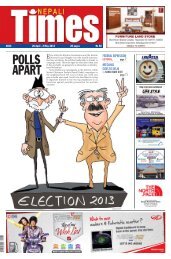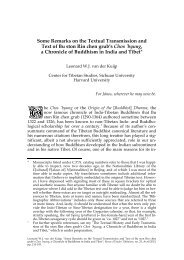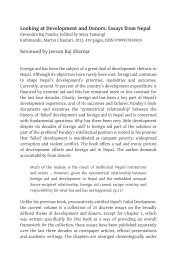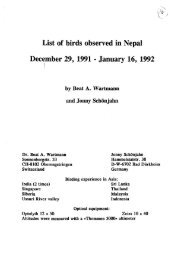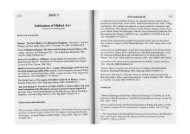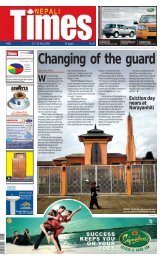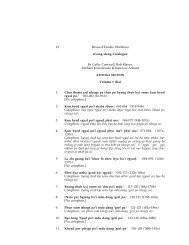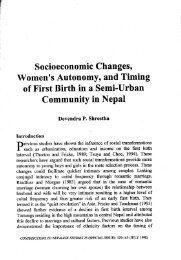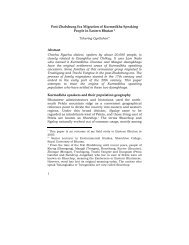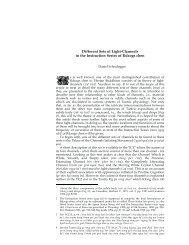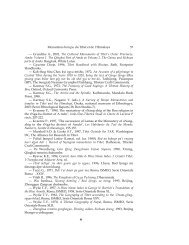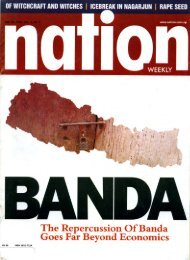Nepali Times - Digital Himalaya
Nepali Times - Digital Himalaya
Nepali Times - Digital Himalaya
Create successful ePaper yourself
Turn your PDF publications into a flip-book with our unique Google optimized e-Paper software.
MIN BAJRACHARYA<br />
MIN BAJRACHARYA<br />
10 TOURISM 3 - 9 NOVEMBER 2000 NEPALI TIMES<br />
Manaslu<br />
8163<br />
Himalchuli<br />
7893<br />
Kathmandu<br />
Ganesh II, III, IV<br />
Ganesh I<br />
7429<br />
The next best thing to<br />
climbing mountains<br />
on foot while in Nepal<br />
is to take the awesome flight<br />
that gives you instant<br />
Everest. This unique<br />
journey—one of the few<br />
airline flights in the world<br />
that takes off and lands from<br />
the same airport—has now<br />
become a must-do for most<br />
tourists visiting Nepal.<br />
The success of the flights<br />
has now spawned an entire<br />
sub-sector of Nepal’s<br />
tourism industry that caters<br />
just to giving tourists a quick<br />
flypast of the highest<br />
mountain in the world. As<br />
word spread through tour<br />
operators, through the huge<br />
box-office success of the<br />
IMAX film Everest a couple<br />
of years back and by wordof-mouth,<br />
air treks have<br />
become the rage in 2000.<br />
Tourism arrivals to Nepal<br />
may have fallen slightly, but<br />
the number of tourists taking<br />
the Everest Flypast has<br />
quadrupled in the past three<br />
years. In the current tourism<br />
season (September to<br />
December) alone, an<br />
estimated 35,000 visitors<br />
will take the $109-a-shot<br />
flights that wing you past the<br />
central and eastern<br />
<strong>Himalaya</strong>. And for the first<br />
time this year, the flights were<br />
not affected by the monsoons<br />
as airlines have acquired<br />
higher-flying pressurised<br />
aircraft. You may be in the<br />
middle of a torrential<br />
downpour or in mist at<br />
Kathmandu, but the mountain<br />
flight will still take off, climb<br />
steeply over the Kathmandu<br />
Valley to get above the clouds,<br />
and give you a majestic fly-past<br />
of the world’s highest<br />
mountains.<br />
Drawn by the bonanza, new<br />
airlines specialising in<br />
mountain flights have come up.<br />
Some like Buddha Air and<br />
Mountain Air have introduced<br />
large-windowed Beech 1900Cs<br />
and Ds, which are much better<br />
suited for sightseeing flights<br />
than earlier planes. There are<br />
no aisle seats, and Mountain<br />
Air has even painted a<br />
panorama of Mt Everest on its<br />
fuselage so passengers get a<br />
preview of what they are in for,<br />
even before they get airborne!<br />
Actually, most flights in<br />
Nepal are mountain flights in<br />
one way or another. You pay<br />
for the ticket to your<br />
destination and the view is a<br />
bonus. The regular<br />
Kathmandu-Pokhara shuttle<br />
gives passengers magnificent<br />
views of the central <strong>Himalaya</strong><br />
from Ganesh, Himalchuli to<br />
INSTANT EVER<br />
For those who can’t trek up the highest mountains in the world, the<br />
accomplishment of a mountain flight is mountaineering itself.<br />
Annapurna ranges. Pokhara-<br />
Jomson really rubs your nose<br />
at the close-ups of Nilgiri and<br />
Machhapuchhare. The<br />
Kathmandu-Nepalgunj flight<br />
offers a panorama of the<br />
entire <strong>Himalaya</strong> past<br />
Dhaulagiri as well. The flights<br />
to Biratnagar and Tumligtar<br />
from Kathmandu have great<br />
views of Mt Everest and<br />
Makalu. Even international<br />
flights offer great scenery—<br />
some of the best ones being<br />
the flights westwards to Delhi,<br />
the Gulf or European<br />
destinations which fly parallel<br />
to the <strong>Himalaya</strong> for half-anhour<br />
before turning south, or<br />
the flights to Dhaka and<br />
Hong Kong which overfly<br />
Biratnagar and therefore give<br />
passengers an unsurpassed<br />
view of the entire eastern<br />
<strong>Himalaya</strong> up to even<br />
Kangchendzonga and<br />
Chomolhari in Bhutan. But<br />
the regular airline flight with<br />
by far the best views is the<br />
thrice-weekly China<br />
Southwest flight between<br />
Kathmandu and Lhasa. If you<br />
are on economy, make sure<br />
you get a seat at the back of<br />
the plane for unobstructed<br />
views of Makalu, Chamlang,<br />
Lhotse and Mt Everst gliding<br />
past at almost eye-level.<br />
We have come a long way<br />
“A REGAL ORNAMENT”<br />
since a Gypsy Moth piloted by<br />
LVS Blacker made the firstever<br />
aerial “conquest” of Mt<br />
Everest in 1933. Flying up<br />
from India, Blacker survived<br />
an open cockpit and icy galeforce<br />
winds in his flimsy<br />
biplane to become the first<br />
person to look down at the top<br />
of the world. Thus began a<br />
glorious tradition of flying up<br />
to Mt Everest.<br />
Nepal has also come a long<br />
way since the days of rickety,<br />
noisy planes with portholes.<br />
Gone are the times when<br />
passengers were allocated seats<br />
next to the engine where all<br />
they saw was a reflection of<br />
themselves on its thundering<br />
aluminium skin. Royal Nepal<br />
Airlines began condu-cting<br />
mountain flights from the days<br />
of the DC-3 in the 1960s,<br />
which despite the noisy<br />
unpressurised cabin had slow<br />
speed, low wings and small<br />
engines and were not at all bad<br />
for views. Foreign dignitaries<br />
visiting Nepal like UN<br />
An excerpt from an account by Dag Hammarskojld, the former UN Secretary General, of his<br />
Mt Everest flight 40 years ago.<br />
After sunrise the next morning, the haze had gone and the sky was without a cloud.<br />
When we came down to the airstrip, the icy summits of the closest mountains stood out<br />
sharply over the green hills around the valley.<br />
We flew through the valleys in the direction of Gauri Shankar and Everest. Even if we<br />
had never come to these mountains, it would have been a great experience just to see the<br />
beauty of the valleys and of the hillsides in the early morning light, the structure of the<br />
landscape, and the picturesque way in which cultivation and villages have developed. The<br />
plane in which we were flying was a DC-3, nonpressurised and without oxygen. That<br />
naturally set an altitude limit for the flight, we flew at a height of twelve to fifteen thousand<br />
feet. Our route took up first under the overwhelming south wall of Gauri Shankar, with its<br />
beautiful double summit consecrated to the two Hindu deities that give the mountain its<br />
name. At our altitude we needed to approach it at mid-height. Its vast size gave the<br />
impression that we were even closer to the mountainside than we were.<br />
Makalu mis-identified as Everest in the article.<br />
Forbidding in its bold, sculptural structure, it was a world far beyond human<br />
comprehension and of the harsh purity we are accustomed to find in the miniature world of crystals. But here it met the eye in<br />
proportions that reduced our human world to a microcosm. Everest wore a plume of snow, made by strong northwesterly winds…it<br />
had a special rank and position marked with a truly regal ornament.<br />
(From the National Georgraphic, January 1961)<br />
Langtang<br />
7225<br />
Gang Chenpo<br />
6379<br />
Dorje Lakpa<br />
6486<br />
Loupo Gang<br />
7083<br />
Phurbi Ghyachu<br />
6658<br />
○ ○ ○ ○ ○ ○ ○ ○ ○ ○ ○ ○ ○ ○ ○ ○ ○ ○ ○ ○ ○ ○ ○ ○ ○ ○ ○ ○ ○ ○ ○ ○ ○ ○ ○ ○ ○ ○ ○ ○ ○ ○ ○ ○ ○ ○ ○ ○ ○ ○ ○ ○ ○ ○ ○ ○ ○ ○ ○ ○ ○ ○ ○ ○ ○ ○ ○ ○ ○ ○ ○ ○ ○<br />
Secretary General Dag<br />
Hammarskjold in 1961 were<br />
allowed by King Mahendra to<br />
take a DC-3 on a flight to Mt<br />
Everest (see box).<br />
Later, Royal Nepal<br />
introduced the turboprop HS-<br />
748, which flew at 19,000 ft<br />
but had large bulbous engine<br />
nacelles that made the whole<br />
front part of the aircraft fairly<br />
useless for views. Then there<br />
were the aisle seats, which<br />
made many passengers feel<br />
short-changed. The state-run<br />
Actually, most flights in Nepal are<br />
mountain flights in one way or another.<br />
You pay for the ticket to your<br />
destination and the view is a bonus.<br />
airline sometimes even<br />
conducted mountain flights<br />
using Twin Otters, which gave<br />
great views of the river gorges<br />
below but not much of the<br />
mountains above.<br />
In comparison, today’s Mt<br />
Everest flights are much more<br />
geared to hardcore mountain<br />
viewing. The Beech 1900s<br />
have brought a virtual<br />
revolution in sightseeing, and<br />
their cruising altitude of<br />
25,000 ft gives an unsurpassed<br />
perspective on the moun-tains:<br />
from the violet-brown expanse<br />
of the Tibetan plateau to the<br />
north punctuated by dark blue<br />
lakes, the jagged icy wall of the<br />
<strong>Himalaya</strong>, and the velvet<br />
foothills of Nepal that plunge<br />
down to the haze-filled plains.<br />
The mountains look almost<br />
holy in their magnificence and<br />
their expanse, and if you are<br />
aware of the genesis of the<br />
FOR BOOKINGS<br />
Choba Bhamare<br />
5960<br />
<strong>Himalaya</strong> you can imagine<br />
the enormous tectonic forces<br />
that must have caused the<br />
Indian landmass to collide<br />
head-on with the Eurasian<br />
plate resulting in this pile-up.<br />
The collision sent the rocks<br />
soaring nearly to the<br />
stratosphere, to heights of<br />
more than 29,000 ft—and<br />
looking out of the window,<br />
the summits of many of the<br />
mountains are even higher<br />
than the plane!<br />
It was only after the<br />
deregulation of the domestic<br />
airline industry in Nepal that<br />
private airlines started gearing<br />
up for the profitable<br />
sightseeing flights. Three<br />
airlines, in particular, have<br />
made the Mt Everest flights<br />
their niche markets: Buddha<br />
Air, Mountain Air and<br />
Shangri-La Airways. The cost<br />
is $109 for foreigners,<br />
IRs3,000 for Indians and Rs<br />
4,800 for <strong>Nepali</strong>s.<br />
Other airlines like Necon<br />
Air and Cosmic Air also<br />
operate mountain flights, but<br />
these make up a smaller<br />
proportion of their total<br />
revenue. Yeti Airlines is<br />
beginning once-daily<br />
mountain flights in its 30seater<br />
EMB-120 on 10<br />
November. Cosmic and Yeti<br />
have aisle seats and the<br />
airlines do not guarantee you<br />
a window seat, although<br />
Necon says it sells only 23<br />
seats at the back of its ATR-<br />
42 and offers a $164 couple<br />
discount for a second person<br />
sitting on the aisle.<br />
The most frequently asked<br />
question aside from which<br />
airline offers the best views is<br />
which side of the plane it is<br />
AIRLINE PHONES AIRCRAFT<br />
Buddha Air 542494, 437025 Beech 1900D<br />
Cosmic Air 241053, 244955 SAAB 340<br />
Gorkha Airways 436576,436579 Dornier DO-228<br />
Mountain Air 489065 Beech 1900C<br />
Necon Air 480565 ATR-42<br />
Shangri-La Air 439692,416028 Beech 1900C<br />
Yeti Airlines 421294,421215 EMB-120 (from 10 Nov)<br />
(Note: Fares may vary depending on the travel agent, but the airline<br />
fare is $109 for all tourists, except Indians who pay IRs 3,000 and<br />
<strong>Nepali</strong>s pay Rs 4,800)




